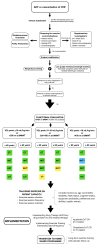Exercise Training in Patients with Heart Failure: From Pathophysiology to Exercise Prescription
- PMID: 39076241
- PMCID: PMC11273657
- DOI: 10.31083/j.rcm2304144
Exercise Training in Patients with Heart Failure: From Pathophysiology to Exercise Prescription
Abstract
Heart failure (HF) is a chronic, progressive, and inexorable syndrome affecting worldwide billion of patients (equally distributed among men and women), with prevalence estimate of 1-3% in developed countries. HF leads to enormous direct and indirect costs, and because of ageing population, the total number of HF patients keep rising, approximately 10% in patients 65 years old. Exercise training (ET) is widely recognized as an evidence-based adjunct treatment modality for patients with HF, and growing evidence is emerging among elderly patients with HF. We used relevant data from literature search (PubMed, Medline, EMBASE) highlighting the epidemiology of HF; focusing on central and peripheral mechanisms underlying the beneficial effect of ET in HF patients; and on frail HF elderly patients undergoing ET. Since many Countries ordered a lockdown in early stages pandemic trying to limit infections, COVID-19 pandemic, and its limitation to exercise-based cardiac rehabilitation operativity was also discussed. ET exerts both central and peripheral adaptations that clinically translate into anti-remodeling effects, increased functional capacity and reduced morbidity and mortality. Ideally, ET programs should be prescribed in a patient-tailored approach, particularly in frail elderly patients with HF. In conclusion, given the complexity of HF syndrome, combining, and tailoring different ET modalities is mandatory. A procedural algorithm according to patient's baseline clinical characteristics [i.e., functional capacity, comorbidity, frailty status (muscle strength, balance, usual daily activities, hearing and vision impairment, sarcopenia, and inability to actively exercise), logistics, individual preferences and goals] has been proposed. Increasing long-term adherence and reaching the frailest patients are challenging goals for future initiatives in the field.
Keywords: COVID-19; cardiac rehabilitation; continuous training; elderly; exercise training; frailty; functional electrical stimulation; heart failure; inspiratory muscle training; interval training; mortality; preserved ejection fraction; respiratory training; strength training.
Copyright: © 2022 The Author(s). Published by IMR Press.
Conflict of interest statement
The authors declare no conflict of interest. Francesco Giallauria is serving as one of the Editorial Board members of this journal. We declare that Francesco Giallauria had no involvement in the peer review of this article and has no access to information regarding its peer review. Full responsibility for the editorial process for this article was delegated to Kazuhiro P. Izawa and Peter H. Brubaker.
Figures



Similar articles
-
Exercise training in patients with chronic heart failure: A new challenge for Cardiac Rehabilitation Community.Monaldi Arch Chest Dis. 2018 Sep 6;88(3):987. doi: 10.4081/monaldi.2018.987. Monaldi Arch Chest Dis. 2018. PMID: 30189716 Review.
-
Enhanced External Counterpulsation (EECP): An Evidence-Based Analysis.Ont Health Technol Assess Ser. 2006;6(5):1-70. Epub 2006 Mar 1. Ont Health Technol Assess Ser. 2006. PMID: 23074496 Free PMC article.
-
Exercise-based cardiac rehabilitation for adults with heart failure.Cochrane Database Syst Rev. 2019 Jan 29;1(1):CD003331. doi: 10.1002/14651858.CD003331.pub5. Cochrane Database Syst Rev. 2019. Update in: Cochrane Database Syst Rev. 2024 Mar 7;3:CD003331. doi: 10.1002/14651858.CD003331.pub6. PMID: 30695817 Free PMC article. Updated.
-
Frailty Status Modifies the Efficacy of Exercise Training Among Patients With Chronic Heart Failure and Reduced Ejection Fraction: An Analysis From the HF-ACTION Trial.Circulation. 2022 Jul 12;146(2):80-90. doi: 10.1161/CIRCULATIONAHA.122.059983. Epub 2022 May 26. Circulation. 2022. PMID: 35616018 Free PMC article. Clinical Trial.
-
Exercise-based cardiac rehabilitation for chronic heart failure: the EXTRAMATCH II individual participant data meta-analysis.Health Technol Assess. 2019 May;23(25):1-98. doi: 10.3310/hta23250. Health Technol Assess. 2019. PMID: 31140973 Free PMC article. Review.
Cited by
-
Exercise-based training programs for patients with chronic Chagas cardiomyopathy: A systematic review and meta-analysis.Int J Cardiol Heart Vasc. 2023 Aug 18;48:101256. doi: 10.1016/j.ijcha.2023.101256. eCollection 2023 Oct. Int J Cardiol Heart Vasc. 2023. PMID: 37794957 Free PMC article.
-
Potential Role of Global Longitudinal Strain in Cardiac and Oncological Patients Undergoing Cardio-Oncology Rehabilitation (CORE).Clin Pract. 2023 Mar 7;13(2):384-397. doi: 10.3390/clinpract13020035. Clin Pract. 2023. PMID: 36961060 Free PMC article. Review.
References
-
- Gheorghiade M, Ambrosy A. Heart failure in 2010: one step forward, two steps back. Nature Reviews Cardiology . 2011;8:72–73. - PubMed
-
- GBD 2017 Disease and Injury Incidence and Prevalence Collaborators Global, regional, and national incidence, prevalence, and years lived with disability for 354 diseases and injuries for 195 countries and territories, 1990–2017: a systematic analysis for the Global Burden of Disease Study 2017. Lancet . 2018;392:1789–1858. - PMC - PubMed
-
- Cook C, Cole G, Asaria P, Jabbour R, Francis DP. The annual global economic burden of heart failure. International Journal of Cardiology . 2014;171:368–376. - PubMed
Publication types
LinkOut - more resources
Full Text Sources
Research Materials
Miscellaneous

